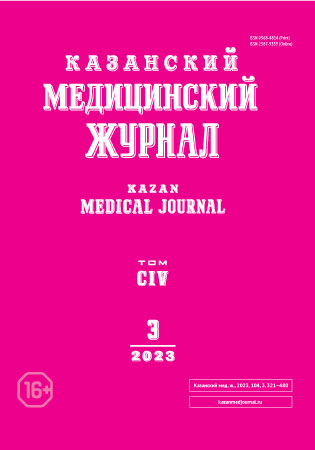Immediate results of surgical treatment of autoimmune thyroiditis with the introduction of advanced surgical techniques
- Authors: Sadikhov F.G.1
-
Affiliations:
- Scientific Center of Surgery named after M.A. Topchubashov
- Issue: Vol 104, No 3 (2023)
- Pages: 461-468
- Section: Clinical experiences
- Submitted: 23.05.2023
- Accepted: 23.05.2023
- Published: 26.05.2023
- URL: https://kazanmedjournal.ru/kazanmedj/article/view/456420
- DOI: https://doi.org/10.17816/KMJ456420
- ID: 456420
Cite item
Abstract
Background. Immediate postoperative complications in the surgical treatment of autoimmune thyroiditis range from 8.5 to 15.0% of the total number of operated patients.
Aim. Improving the results of surgical treatment of patients with autoimmune thyroiditis through the introduction of advanced surgical techniques and the use of CO2 laser in surgical interventions.
Material and methods. The immediate postoperative results of surgical treatment of patients with autoimmune thyroiditis at the clinical base of the Scientific Center for Surgery named after M.A. Topchibashev for 2015–2021 were studied. The analysis was carried out in two groups with the inclusion of data from 207 operated patients aged 27 to 73 years, mostly patients with hypertrophic form of AIT. There were 183 (88.4%) women and 24 (11.6%) men. The first group consisted of 96 (46.4%) patients who underwent an advanced surgical technique using a CO2 laser. The second group included 111 (53.6%) patients who underwent surgery using traditional methods. The immediate postoperative specific complications (paresis of the larynx and hypoparathyroidism) and the results of surgical treatment of patients in two groups were compared. To test the statistical significance of differences, nonparametric Pearson's χ2 and Student's t tests were used. Differences were considered statistically significant at p <0.050.
Results. The number of patients with complications among the patients of the first group was 3 (3.1%), among the patients of the second group — 16 (14.4%) (χ2=7.870, p=0.006). The greatest number of complications was noted in patients with large goiter and recurrence of the disease in those previously operated on for autoimmune thyroiditis. The proposed method using a CO2 laser in the surgical treatment of patients with autoimmune thyroiditis can reduce the incidence of laryngeal paresis (χ2=4.057, p=0.044), hypoparathyroidism (χ2=4.381, p=0.037) and mortality (χ2=3.840, p=0.050), reduce the duration of hospital stay by 22% — from 9.6 to 7.4 days (t=2.588, p=0.007).
Conclusion. The use of advanced surgical techniques, the performance of the operation in an adequate volume and the use of a CO2 laser made it possible to reduce the number of postoperative complications and improve the results of treatment of patients with autoimmune thyroiditis.
Full Text
About the authors
Fatta G. Sadikhov
Scientific Center of Surgery named after M.A. Topchubashov
Author for correspondence.
Email: fetta.sadixov@gmail.com
ORCID iD: 0000-0002-6779-8796
M.D., Cand. Sci. (Med.), Researcher, Depart. of Endocrine Surgery
Azerbaijan, Baku, AzerbaijanReferences
- Greentsov AG, Akhrameyev VB, Matiytsiv AB, Grintsov GA, Khristulenko AA. Risk factors of intraoperative complications in benign thyroid diseases and their prevention. Tavricheskiy mediko-biologicheskiy vestnik. 2020;23(2):64–68. (In Russ.) doi: 10.37279/2070-8092-2020-23-2-64-68.
- Antonyuk OS, Shapovalov IN, Shtoda DE, Denisov AV, Yaroshchak SV, Vlasov EI, Holubytskyi KO. Long-term results of surgical treatment of Hashimoto disease. Bulletin of urgent and recovery surgery. 2020;5(4):7–12. (In Russ.)
- Billmann F, Bokor-Billmann T, Zapshyn H. Minimal-assisted thyroidectomy for benign disease: A retrospective analysis of risk factors for postoperative complications. Int J Surg. 2014;12(12):1306–1309. doi: 10.1016/j.ijsu.2014.11.002.
- Troshina EA, Panfilova EA, Mikhina MS, Sviridonova MA. Thyroiditis. Guidelines (to help a practitioner). Consilium Medicum. 2019;21(12):10–22. (In Russ.) doi: 10.26442/20751753.2019.12.1906836.
- Agaev RM, Sadyhov FG, Gardashov NT. Evaluation of immediate and distant results of treatment of patients with autoimmune thyroiditis. Bulletin of Pirogov National Medical & Surgical Center. 2021;16(3):42–46. (In Russ.) doi: 10.25881/20728255_2021_16_3_42.
- Rozhko VA. Current state of the autoimmune thyroiditis problem. Health and Ecology Issues. 2019;(2):4–13. (In Rus.) doi: 10.51523/2708-6011.2019-16-2-1.
- Gan T, Randle RW. The role of surgery in autoimmune conditions of the thyroid. Surg Clin North Am. 2019;99(4):633–648. doi: 10.1016/j.suc.2019.04.005.
- Boldyreva YV, Lebedev IA, Kruchinin EV, Alekberov RJ, Tarasov DO, Tyapkin AV, Kozlov MV, Akhmetianov MA, Lukashenok AV, Mokin EA, Fidomatova ZSh. A unified approach to patient management with autoimmune thyroiditis (literature review). Uralskiy meditsinkiy zhurnal. 2019;175(7):110–113. (In Russ.) doi: 10.25694/URMJ.2019.07.25.
- Bezrukov OF. Surgery of thyroid gland: objects and unsolved problems. Grekov's Bulletin of Surgery. 2015;174(1):73–74. (In Russ.) doi: 10.24884/0042-4625-2015-174-1-73-74.
- Sadikhov FG. Comprehensive treatment of patients with autoimmune thyroiditis using laser technologies. Kazan Medical Journal. 2022;103(5):856–863. (In Russ.) doi: 10.17816/KMJ2022-856.
- Colin MD, Gilbert HD. Chronic autoimmune thyroiditis. NEJM. 2016;(335):99–107. doi: 10.1056/NEJM199607113350206.
- Moon JH, Hyun MK, Lee JY, Shim JI, Kim TH, Choi HS, Ahn HY, Kim KW, Park DJ, Park YJ, Yi KH. Prevalence of thyroid nodules and their associated clinical parameters: A large-scale, multicenter-based health checkup study. Korean J Intern Med. 2018;33(4):753–762. doi: 10.3904/kjim.2015.273.
- Sheremet MI, Sydorchuk LP, Shidlovskyi VO, Desiateryk VI, Kovalenko AE, Shevchenko SI, Zavgorodnyi SM, Tkachuk NP, Piddubna AA. The activity of proliferation and apoptosis of thyrocytes in the thyroid tissue of patients of nodular goiter with autoimmune thyroiditis considering the polymorphism of the BCL-2 (RS17759659), CTLA-4 (RS231775), APO-1/FAS (RS2234767) genes. Biointerface Research in Applied Chemistry. 2020;10(2): 5201–5208. doi: 10.33263/BRIAC102.201208.
- Zdor VV. Correlation of hormonal and cytokines regulation in case of autoimmune thyroiditis. Clinical and experimental thyroidology. 2017;13(2):45–56. (In Russ.) doi: 10.14341/ket2017245-56.
- Geltser BI, Zdor VV, Kotelnikov VN. Evolution of the views on pathogenesis of autoimmune thyroid diseases and prospects for their target therapy. Klinicheskaya meditsina. 2017;95(6):524–534. (In Russ.) doi: 10.18821/0023-2149-2017-95-6-524-534.
- Maistrenko NA, Romaschenko PN, Krivolapov DS, Prishvin AP. The concept of examination and treatment of surgical diseases of the thyroid gland. Tavricheskiy mediko-biologicheskiy vestnik. 2017;20(3-2):163–170. (In Russ.) doi: 10.23670/IRJ.2017.55.165.
- Abrosimov AYu. New international histological classification of thyroid tumors. Archive of Pathology. 2018;80(1):37–45. (In Russ.) doi: 10.17116/patol201880137-45.
- Beltsevich DG, Vanushko VE, Melnichenko GA, Rumyantsev PO, Fadeyev VV. Russian Association of Endocrinologists clinic guidelines for thyroid nodules diagnostic and treatment. Endocrine Surgery. 2016;10(1):5–12. (In Russ) doi: 10.14341/serg201615-12.
- Agayev RM, Sadikhov FQ. Studying the distant results of treatment of autoimmune thyroiditis. Health. 2021;27(3):27–37.
Supplementary files






